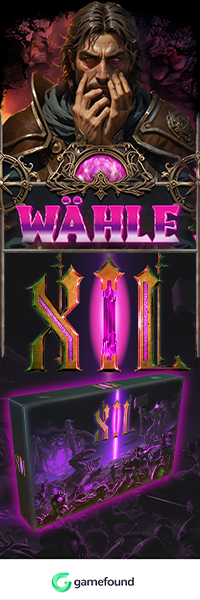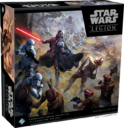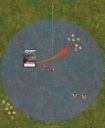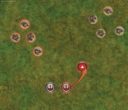Star Wars Legion: Command & Control
Fantasy Flight Games erklären weitere Regeln zu Star Wars: Legion.
“Look, Your Worshipfulness, let’s get one thing straight. I take orders from just one person: me.”
–Han Solo, Star Wars: A New HopeThe grand strategies of war can be carefully planned—accounting for supply lines, maneuvering armies and armadas to apply maximum pressure, or painstakingly plotting a vital ambush. Still, even the greatest plans must alter—if not crumble—upon contact with the enemy. When the concussive blast of thermal detonators mixes with the hiss of blaster fire and brutal cries of melee combat, even veteran soldiers may struggle to remember orders and prioritize their objectives.
In your games of Star Wars™: Legion, you take on the gripping role of an infantry commander in the Star Wars universe, leading your troops and vehicles into battle on one of the countless unseen battlefields of the Galactic Civil War. Your forces are well trained and you know your objectives, but your army is not a machine that can respond instantaneously to every command. You’ll need to deliver orders to your troops to impose your will on the chaos of battle, and in today’s preview of Star Wars: Legion, we’ll look closer at command cards, ordering your troops, and how you’ll turn your greatest plans into action.
Choosing a Plan
Your battles in Star Wars: Legion unfold over the course of six rounds. During these six rounds, you’ll lead glorious infantry charges, send powerful vehicles stomping forward or zipping across the battlefield, and join iconic heroes and villains in lethal lightsaber duels. But just as every battle begins with a single order, every round of Star Wars: Legion begins with you and your opponent secretly selecting command cards.
The command card that you choose comes from a hand of seven carefully chosen command cards that you’ll assemble before the game begins, as part of building your army. Both factions have access to a few neutral command cards, such as Push, but every commander in Star Wars: Legion also comes with three unique command cards, such as New Ways to Motivate Them or Return of the Jedi. These command cards represent a commander’s signature tactics or characteristic leadership, and with the special powers they carry, they’re almost always more powerful than the neutral command cards. You can’t use command cards over and over, however. After a command card is used, it’s discarded and can never be used again during this game!
Whichever command card you choose at the beginning of the round, it sets the tone for your army’s maneuvers, because these command cards determine two vital pieces of information—which player has priority and how many units can receive your orders this round.
In the upper-left corner of every command card, you will see a number of pips. If your command card has fewer pips than your opponent’s, you win priority—the chance to act first throughout the round! Activating first can be a powerful tactical advantage for you to harness—if you make the first attack, there’s a good chance you could pin an enemy down with blaster fire or inflict losses before that unit has a chance to activate.
There’s always a balance that must be maintained, however. Cards like Ambush, with only a single pip for priority, give you a very good chance of going first. But in exchange, you can only give orders to a single unit. Considering the balance between priority and the number of orders you issue, and choosing the perfect command card for your strategy each round is just the first of the choices you’ll make during the command phase.
Issue Your Orders
If your command card determines the broad strategy that you plan to execute this round, the orders that you deliver to your troops are your primary way to impose your will on the unfolding battle. Your command card determines how many units you can order, but all of your orders ultimately originate from your commander—an iconic character like Luke Skywalker or Darth Vader.
Every unit in a game of Star Wars: Legion has an order token displaying that unit’s rank on the battlefield—commander, corps, special forces, support, or heavy. (You can see examples of these order tokens above.) When issuing orders, you simply choose units within Range 3 of your commander and place those units’ order tokens next to them. Of course, you’re limited to the number of orders shown in the orders section of your command card. Once you’ve assigned your orders, all of your unused order tokens (corresponding to the unordered units in your army) are shuffled facedown or placed in a bag to randomize them.
For instance, in the example above, you have played Push, which allows you to order any two units within range of your commander, Darth Vader. One unit of Stormtroopers is outside Darth Vader’s command radius, and cannot be ordered. You decide to issue orders to Darth Vader, placing a commander order token by him, and the second unit of Stormtroopers, placing a corps order token by them. The order tokens for the 74-Z Speeder Bikes and one unit of Stormtroopers are randomized by shuffling them facedown.
Essentially, the orders that you issue cut through the chaos and uncertainty of battle to give you control over exactly when a unit will activate. You and your opponent will alternate activating units, and every time it’s your turn, you face a choice. You could activate a unit that you issued orders to, sending your plans cascading into action as Rebel Troopers open fire or Darth Vader stalks unstoppably forward. Or, you may draw a random order token from your unused order tokens and activate any unit with the corresponding rank.
In the diagram above, the Rebel player randomly draws an order token showing the corps rank. He can use this to activate any unit sharing that rank, such as one of the Rebel Trooper units shown above.
Every unit in your army will activate during every round of the game—but if you don’t issue orders to a unit, you can’t predict exactly when that unit may activate. In one round, you may need your 74-Z Speeder Bikes to hold off until the last possible second, waiting on your wing before zipping forward to strafe enemy troopers. Or, perhaps Darth Vader and Luke Skywalker are caught in a deadly lightsaber battle, and you desperately need to strike first in the duel. By assigning orders to your units, you can be certain that they will activate exactly when you need them to—whether early or late.
If a unit in your army did not receive orders from your commander, you must activate them when you draw their order token—and at certain times, that means adapting to the chaos of battle and activating a unit before you planned. This is hardly the end for a seasoned commander, however—navigating the challenging command system of Star Wars: Legion and issuing your orders to just the right units are the momentous choices that define every game of Star Wars: Legion.
Move on Their Position!
The battle is raging around you as you fight for freedom or tyranny on another war-torn battlefield of the Galactic Civil War.
Der deutschen Vertrieb der Fantasy Flight Produkte liegt bei Asmodee.
Quelle: Fantasy Flight Games













Was für ein Schrott-Aktivierungssystem! Binden wir dem Spieler wieder einen Klotz ans Bein.
Das hat schon bei Armada nicht funktioniert!
Das Spiel wird sich leider wieder wie geschnitten Brot verkaufen, nur weil da „Star Wars“ drauf steht.
Ich finde das Aktivierungssystem gar nicht schlecht, versucht so ne Art Fog of War zu simulieren. Muss man sich drauf einlassen. I go you go ist so ausgelutscht. Und nebenbei, ebenso Armada funktioniert sehr gut was die aktivierungen anbelangt, da nervt eher die Karten-Aufrüstungspirale.
Den Clausewitzschen Nebel des Krieges gibt es nicht bei Star Wars Legion, denn die Spieler haben die perfekte Information. Was das Kommandosystem ein bißchen simuliert, ist ein anderer von Carl v. Clausewitz eingeführter Begriff: Friktion. Kein realer Kommandeur hat wie ein Schachspieler die absolute Kontrolle über seine Truppen, Befehle werden nicht verstanden, kommen nicht an, werden verzögert ausgeführt: es gibt Reibungsverluste.
Also ich für meinen Teil , hatte Spaß beim antesten auf der spiel in essen und fand die Art der Aktivierung super spannend, brachte so einen pocker Effekt und taktisches planungspiel mit den verfügbaren Einheiten 😄👍
Die Kartenaufrüstungsspirale wird es vielleicht wieder geben. FFG verdient damit ja hauptsächlich sein Geld.
Der Spieler braucht möglichst viele Klötze am Bein. Kein echter Kommandeur hat wie ein Schachspieler perfekte Kontrolle und perfekte Information. Es ist unrealistisch genug, dass mit einem Blick auf den Tisch schon alles klar ist und niemand Reserven zurückhalten muss.
Wenn die Miniaturen was taugen, habe sie noch nicht selbst gesehen, werde ich mir da etwas schönes mit dem Flying Lead Regelsystem basteln und auf diesen FFG Regelmist sch… 🙂
Also ich finde das Aktivierungssystem jetzt nicht so schlecht. Es ist eben eine alternierende Aktivierung zwischen den Einheiten, wobei die Reihernfolge zufällig bestimmt wird, mit Ausnahme der Einheiten, denen man Befehle erteilen konnte.
Die ansatzweise Diskussion ist durchaus spannend zu beobachten:
Regeln gut – Spiel kaufen
Regeln schlecht – Spiel nicht kaufen
Regeln schlecht, Miniaturen gut – Spiel kaufen
Meiner einer: finde die Miniaturen schlecht – kaufe das Spiel definitiv nicht. Mal schauen, wie es weiter geht… 😀
Sehr schön erklärt!
So funktioniert es ja auch normalerweise. Nur GW schaft es diese Regel ausser kraft zu setzen 🤣
Da sind die Miniaturen aber auch meistens gut.
Ich sehe da eher Forgeworld als Beispiel, dafür diese Regel außer Kraft setzen 😅
Dann mag ich auch mal noch einen Standpunkt hinzufügen.
Genervt vom Ende/Reboot des EU und der FFG Kaufspirale, drum lass ich die Finger davon!
Das ist eben der Star Wars Bonus. Mir wären Modelle von Knight Games auch lieber.
Mir sind bis jetzt noch nie die seltsamen Knie der Sturmtruppen aufgefallen, aber sie sind bei den Minis offensichtlich auch besonders hervorgehoben.
Besteht die Chance, dass die das irgendwann auf die Klonkriege ausdehnen?
Eine ordentliche Grievous – Mini wäre schon nett.
+1 wird Zeit für die Klonkriege, wer spielt Rebellen??
Was ich sehr kritisch sehe ist, dass man einfach eine starke Einheit spamt. Dann kann ich komplett planen und mein Gegner muss auf sein Glück hoffen.